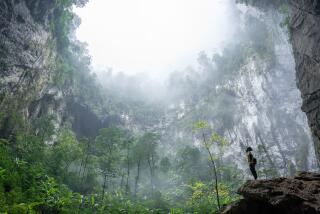Journey to Underworld
- Share via
WAITOMO CAVES, New Zealand — There aren’t many places where you can float through a cave of eternal night, beneath constellations of glowworms.
Your raft on this journey is an inner tube.
You wear a helmet, of course, to protect your head from chance impact with limestone walls or stalactites, and the helmet’s attached miner’s lamp is useful when you lose your way.
The rubber boots come in handy, too, keeping your feet dry while you use them to steer through narrow channels.
It takes about three hours to traverse the dark waters of the subterranean river that flows through the Waitomo Caves a three-hour drive south of Auckland on New Zealand’s North Island.
The Glowworm Grotto
The majority of visitors experience the glowworms and limestone formations during a guided walk into the main Glowworm Cave.
Deep within the cave you board a wooden boat that carries you into Glowworm Grotto where thousands of tiny insects live out their lives, glowing overhead like bright stars in a distant galaxy.
The dark-water rafting adventure takes place in Ruakuri Cave, the second of the three caves, about three kilometers up the valley from Glowworm Grotto.
Much of Ruakuri is not open to the public because of its vastness, hidden under the ledge of a sheer cliff. A guided walk leads into a large cavern and then into a narrow passageway called Ghost Walk.
The next chamber and passageway, carved out of limestone by centuries of dripping water, take you to narrow bridges over a rushing underground river. You can hear the roar of an unseen waterfall. Clusters of glowworms sparkle along the river’s edge and overhead.
Ruakuri Cave
Black-water rafters have their own entrance to Ruakuri Cave. Two guides lead as many as a dozen rafters at a time.
Sometimes the dark waters ripple along gently, as they do on a white-water river. Then they bounce and pick up momentum to provide what rafters are told will be an experience “more than a little thrilling.”
You are asked to disclose any medical ailment or disability. The advisory states: “Although every care is taken, caving is dangerous, so we accept no responsibility for injury. . . .”
The journey is canceled if heavy rains make the underground river too hazardous.
The adventure begins with an audio-visual show at Waitomo Museum and ends with a hot shower and a snack. The price is about $23 U.S. per person.
There are several worthwhile above-ground excursions, too.
The hourlong Opapaka Pa Bush Walk begins at Ohaki Maori Village and, along the looping and sometimes steep track, information boards tell of Maori life in the past.
Marokopa Waterfall
From Ruakuri Cave, another hourlong trek follows the rim of limestone bluffs to a spectacular bridge of natural limestone. Walk the route cautiously at night and you can share the darkness with tiny glowworms. Another forest hike leads to the magnificent Marokopa Waterfall. Above Ruakuri is an ancient Maori burial ground.
The main Glowworm Cave was first explored in 1887 by English adventurer Fred Mace and Maori Chief Taane Tinorau. Maoris had long lived near the entrance to the cave, but superstitions had kept them from entering.
Mace and Tinorau carried candles and, in addition to the glowworms, they found limestone spires reaching up from the floor of the cave and down from the top of the chambers--formations that have come to be known as the Organ Loft, the Cathedral, the Inverted Fairy Castle and, finally, the Modern Art Gallery.
As word of this natural wonder spread, Chief Tinorau and his wife, Huti, began to escort visitors through the first Waitomo cave for a small fee. Eventually, to protect Waitomo against vandalism, the government declared it a Scenic Reserve and took over its administration.
Den of the Dogs
Ruakuri is a Maori name that means “Den of the Dogs,” a reference to the pack of wild dogs that lived in the area before they attacked a hunter and then were wiped out by the tribe.
Around 1910 a young Maori was hunting pigs when one disappeared into the earth. That led to the discovery of Aranui, the third of the Waitomo glowworm caves. One of its walks leads to the Temple of Peace chamber, where stalagmites and stalactites help the imagination re-create various scenes.
Near the caves is the country club-style Waitomo Resort Hotel, with 27 guest rooms and the Fred Mace restaurant, which features regional cuisine. Room rates are about $30 to $60 U.S. double occupancy.
To phone ahead for a dark-water rafting reservation, call Waitomo Museum of Caves at (0813) 87640.
When you are at the caves, pick up a copy of “Waitomo Caves,” an excellent descriptive booklet with full-color photos for about $3 U.S.
For more information on travel to New Zealand, contact the New Zealand Tourist and Publicity Office, 10960 Wilshire Blvd., Suite 1530, Los Angeles 90024, (213) 477-8241.
More to Read
Sign up for The Wild
We’ll help you find the best places to hike, bike and run, as well as the perfect silent spots for meditation and yoga.
You may occasionally receive promotional content from the Los Angeles Times.





